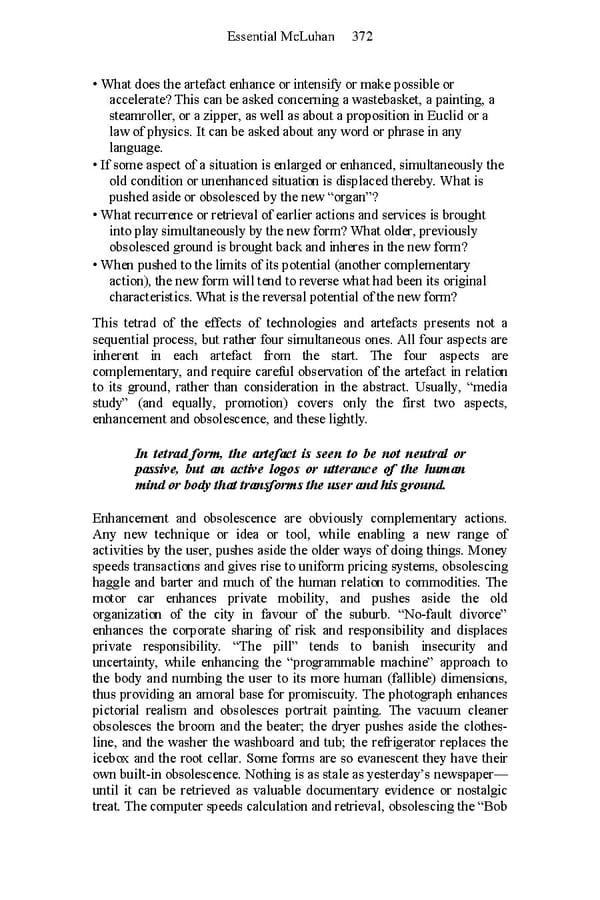Essential McLuhan 372 • What does the artefact enhance or intensify or make possible or accelerate? This can be asked concerning a wastebasket, a painting, a steamroller, or a zipper, as well as about a proposition in Euclid or a law of physics. It can be asked about any word or phrase in any language. • If some aspect of a situation is enlarged or enhanced, simultaneously the old condition or unenhanced situation is displaced thereby. What is pushed aside or obsolesced by the new “organ”? • What recurrence or retrieval of earlier actions and services is brought into play simultaneously by the new form? What older, previously obsolesced ground is brought back and inheres in the new form? • When pushed to the limits of its potential (another complementary action), the new form will tend to reverse what had been its original characteristics. What is the reversal potential of the new form? This tetrad of the effects of technologies and artefacts presents not a sequential process, but rather four simultaneous ones. All four aspects are inherent in each artefact from the start. The four aspects are complementary, and require careful observation of the artefact in relation to its ground, rather than consideration in the abstract. Usually, “media study” (and equally, promotion) covers only the first two aspects, enhancement and obsolescence, and these lightly. In tetrad form, the artefact is seen to be not neutral or passive, but an active logos or utterance of the human mind or body that transforms the user and his ground. Enhancement and obsolescence are obviously complementary actions. Any new technique or idea or tool, while enabling a new range of activities by the user, pushes aside the older ways of doing things. Money speeds transactions and gives rise to uniform pricing systems, obsolescing haggle and barter and much of the human relation to commodities. The motor car enhances private mobility, and pushes aside the old organization of the city in favour of the suburb. “No-fault divorce” enhances the corporate sharing of risk and responsibility and displaces private responsibility. “The pill” tends to banish insecurity and uncertainty, while enhancing the “programmable machine” approach to the body and numbing the user to its more human (fallible) dimensions, thus providing an amoral base for promiscuity. The photograph enhances pictorial realism and obsolesces portrait painting. The vacuum cleaner obsolesces the broom and the beater; the dryer pushes aside the clothes- line, and the washer the washboard and tub; the refrigerator replaces the icebox and the root cellar. Some forms are so evanescent they have their own built-in obsolescence. Nothing is as stale as yesterday’s newspaper— until it can be retrieved as valuable documentary evidence or nostalgic treat. The computer speeds calculation and retrieval, obsolescing the “Bob
 Essential McLuhan Page 378 Page 380
Essential McLuhan Page 378 Page 380